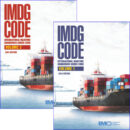 Both the International Civil Aviation Organization (ICAO) and International Maritime Organization (IMO) recently changed the required size of the text to be used when marking the United Nations Identification Number (UNID Number) on packages of dangerous goods/hazardous materials. The UNID Number is a four-digit numerical designator (for example, UN1993) which provides an internationally recognized identification number for the dangerous goods/hazardous materials being transported in that specific packaging that is the same regardless of the transport mode or the body of regulatory rules being followed. The UNID Number is associated with a specific Proper Shipping Name which, with extremely rare exceptions, also remains constant across modes of transport and regulations (for instance, using the example of UN1993, the associated Proper Shipping Name is “Flammable Liquids, N.O.S.”).
Both the International Civil Aviation Organization (ICAO) and International Maritime Organization (IMO) recently changed the required size of the text to be used when marking the United Nations Identification Number (UNID Number) on packages of dangerous goods/hazardous materials. The UNID Number is a four-digit numerical designator (for example, UN1993) which provides an internationally recognized identification number for the dangerous goods/hazardous materials being transported in that specific packaging that is the same regardless of the transport mode or the body of regulatory rules being followed. The UNID Number is associated with a specific Proper Shipping Name which, with extremely rare exceptions, also remains constant across modes of transport and regulations (for instance, using the example of UN1993, the associated Proper Shipping Name is “Flammable Liquids, N.O.S.”).
The new marking rules specify a text size of at least 12mm for marking packages of dangerous goods/hazardous materials greater than 30 kg/30 L gross mass. For packages equal to or less than 30 kg/30 L gross mass, but greater than 5 kg/5 L gross mass, a 6 mm text size is indicated.
Note: Additionally, the IMO’s International Maritime Dangerous Goods (IMDG) Code includes Cylinders of 60 L or less under this 6 mm requirement.
For packages equal to or less than 5 kg/5 L gross mass, it is acceptable to use a text size which is appropriate to the size of the package in question. It should be noted that the word “appropriate” is left undefined as to any specific size indication. The associated prefix “UN” must also be displayed in the same text size as the respective four-digit number. The same size requirements, less the 5 kg/5 L “appropriate” exception, are presently recommended for Package Use and Overpack markings, but are not yet specifically required.
As is typical in these cases, a transition period is provided. In this case, the mandatory date at which packages MUST be so annotated is Jan. 1, 2014. However, it is acceptable to begin using the new marking sizes immediately.
Further information on this change is available at the websites of the IMO, ICAO and the International Air Transport Association (IATA).
* * * * *
Labelmaster carries an extensive suite of hazard class shipping name labels which may be used to help satisfy the text size change and many other regulatory requirements. Labelmaster regulatory personnel are also available to help customers with understanding and clarification of the various rules and their associated timelines. Please feel free to contact us at 800-621-5808.
References: ICAO 2013-2014 Section 5; 2.4.1; A.I.R. Shipper 2013 Section 5.2.4.1 (c) & Explanatory Note under 5.2.2.2; IATA 54thEdition Section 7.1.5.5.1 (with associated note), 7.1.5.5.2; IMO/IMDG Code 36-12 Section 5.2.1.1
Note: The ICAO Technical Instructions 2013-2014, A.I.R. Shipper 2013, and the 54th Edition of the IATA Dangerous Goods Regulations take effect on Jan. 1, 2013; IMO/IMDG Code 36-12 takes effect on Jan. 1, 2014 but is authorized for voluntary use effective Jan. 1, 2013.



Good article … excpet perhaps that needs pointing out that UN continues to say that the PSN “shall be readily visible…..”. Though they do not have to have the minmimum heights sspecified for the UN Number, thought needs to be given to this provision. 2mm high text on a 200 litre drum is not to me “readily visible” in a transport situation.
Mr. Waight,
Thank you for your comment. It is worth noting that while the rules regarding the display of the Proper Shipping Name (PSN) have not changed under this particular circumstance, your caution in reference to size and the requirement that it be “readily visible” remains sound advice.
Paul
Pingback: Required Regulatory Change Affects Marking Text Size for Hazard Class Labels « A Safe place for Dangerous Goods
Pingback: Required Regulatory Change Affects Marking Text Size for Hazard Class Labels « A Safe place for Dangerous Goods
As the regulation change pertains to UN ID mark size I find the title and image, both indicating “Hazard Class Labels”, a bit misleading and confusing. Can you elaborate?
Dear Mr. Tune,
Thank you for inquiry. The title references our hazard label products, and how the regulatory change might impact someone who uses those labels to assist them in marking their packages using those products. However the body of the text directly addresses the regulatory change itself, which indeed does apply specifically to markings. Thank you.
Paul
As the regulation change pertains to UN ID mark size I find the title and image, both indicating “Hazard Class Labels”, a bit misleading and confusing. Can you elaborate?
Dear Mr. Tune,
Thank you for inquiry. The title references our hazard label products, and how the regulatory change might impact someone who uses those labels to assist them in marking their packages using those products. However the body of the text directly addresses the regulatory change itself, which indeed does apply specifically to markings. Thank you.
Paul